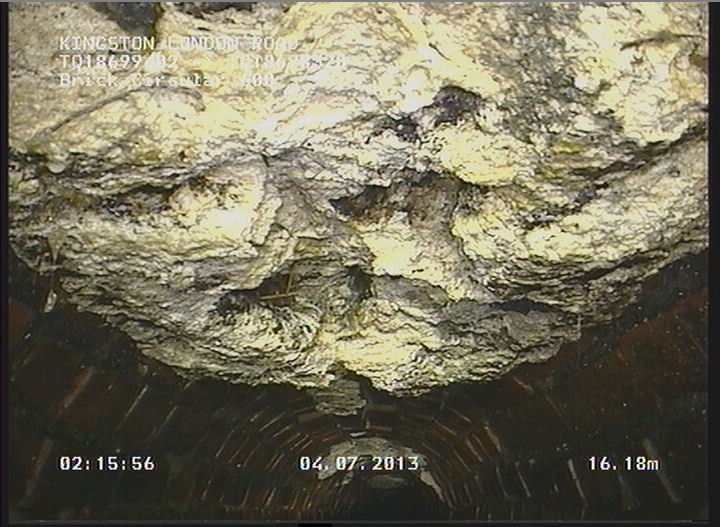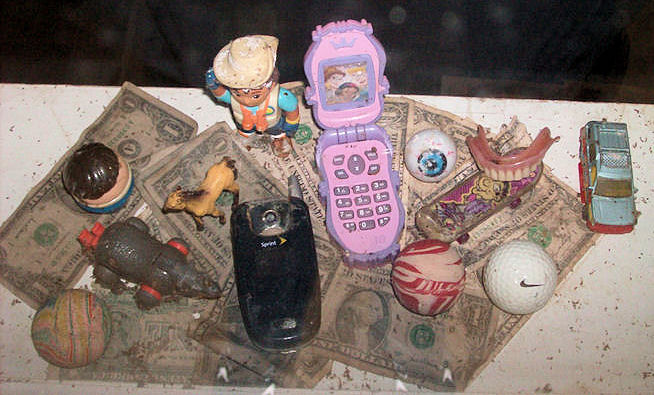
In late July, Thames Water (London) reported that it had removed a 15-ton "fatberg" made of fat mixed with wet wipes from a London sewer. Photo courtesy of Thames Water. Click to see the video.
The packages of wet wipes that have continued to populate store shelves nationwide during the past few years also are accumulating elsewhere — both in collection systems and outreach efforts by the Water Environment Federation (WEF; Alexandria, Va.). Through its outreach efforts, conferences, and magazines, WEF is helping raise awareness on how wet wipes can clog pipes and working to seek solutions.
Organizations collaborate on assessment and labeling
On Sept. 17, WEF and its partner organizations announced an agreement to work together to reduce the burden of nonflushable disposable products in the wastewater system. These organizations include
- the Association of the Nonwoven Fabrics Industry (INDA; Cary, N.C.),
- the National Association of Clean Water Agencies (NACWA; Washington, D.C.), and
- the American Public Works Association (APWA; Washington, D.C.).

Nondispersibles found in the Kennebec Sanitary treatment District (Waterville, Maine) system during a facility inspection. Photo courtesy of Aubrey Strause, Verdant Water PLLC (Scarborough, Maine) owner.
In a joint press release, the organizations stated, “These products have been linked to expensive clogging issues for utilities and can potentially lead to costly sewer back-ups in communities and households across the country. The associations believe that rigorous product assessment before making a flushable claim, along with improved product labeling, would significantly reduce the amount of non-flushable items in the sewer system.”
“Some products are designed to be flushed, while others are not,” said David Rousse, president of INDA. “It is the products that are not designed to be flushed, but get flushed anyway, that are creating the problem for wastewater systems and we are working collaboratively to change this.”
To assist companies with product flushability assessments and to provide guidance on proper labeling, INDA and its European counterpart, EDANA (Brussels, Belgium), recently released a voluntary Code of Practice for manufacturers and marketers of wipes and other disposable nonwoven products, which includes a detailed decision tree to determine the proper labeling of a product.
Before a flushable claim can be made for products intended to be flushed, the product should be subjected to the seven rigorous tests found in INDA’s/EDANA’s newly released “Third Edition Guidance Document for Assessing the Flushability of Nonwoven Disposable Products.”
If a product is not designed to be flushed, but used in a manner in which the consumer might flush it nonetheless, then the Code of Practice prescribes that the product packaging should display the “Do Not Flush” logo prominently and it must be of a minimum size or larger.
WEFTEC continues the dialogue
The discussion of the wipes in the pipes will continue at WEFTEC® 2013 in Chicago. On Wednesday, Oct. 9, wipe manufacturers and a group of experts on collections systems will participate in Technical Session 610, “Wipe Out: Reducing the Burden of Wipes in the Pipes.” A sampling of topics to be covered includes
- what products are really considered flushable,
- quantifying the cost of clogs,
- utilities’ voluntary testing and research, and
- legislative efforts and public outreach.
WE&T reports on 15-ton ‘fatberg’
The November issue of Water Environment & Technology (WE&T) magazine also will examine an extreme and recent high-profile instance of what can happen when nonflushable wipes do make it into the collection system: the 15-ton London “fatberg.”
In late July, Thames Water (London) reported that it had removed Britain’s biggest ever fatberg from a London sewer. The bus-sized lump of wrongly-flushed festering food-fat mixed with wet wipes formed in drains under London Road in Kingston, Surrey, according to a Thames Water press release.
“The sewer was almost completely clogged with over 15 tonnes of fat,” said Gordon Hailwood, waste contracts supervisor for Thames Water. “If we hadn’t discovered it in time, raw [wastewater] could have started spurting out of manholes across the whole of Kingston.” He said that the fatberg was so big it damaged the sewer and estimated that repairs would take up to 6 weeks.
Read about the fatberg as well as its component parts, including fats, oils, and grease; wet wipes; and the other random items that can make their way into a city’s collection system in the WE&T article, “The incredible growing ‘fatberg.’” See more information on the NACWA’s Flushable Wipes and Other Non-Dispersible Products website.
— Steve Spicer, WEF Highlights








October 16, 2013
Featured, WEF Resources & Efforts